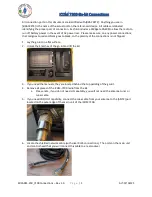
P a g e
|
20
20-62 VHF & UHF TRANSMITTER
Product Manual
Sea Air and Land Communications Ltd, 10 Vanadium Place, Addington, Christchurch 8024, New Zealand
March 2020
Ethernet Configuration
Ethernet configuration is done through the TCP/IP tab.
IP address, Port and Subnet
To use the Ethernet port the 20-62 must be configured with a valid IP address on your network.
See “Selecting an IP address” below.
In addition to the IP address, an Ethernet connection requires a “port” number, as there may be
many “ports” available at an IP address, each corresponding to a different connection on the
device. By default the 20-62 uses port 8234 (in both directions), but this can be changed as
required.
The “Subnet Mask” should normally be set to 255.255.255.0
Client or Server?
The 20-62 may function as either a “client” or a “server” using either TCP/IP or UDP protocol.
When operating as a “TCP/IP Server” it will respond to any device on the local network that
connects to the “Current” or “Static IP address” in the TCP/IP tab. A “remote server address” is
not required. Sacoto will only connect to the 20-62 if it is a TCP/IP Server.
When operating as a “TCP/IP client” it will attempt to connect to a specific server at the IP
address specified in the “Remote server address” field. The “Current” or “Static IP address” is still
required for the IP address of the 20-62 but the remote TCP/IP server does not need to know this.
In TCP/IP client mode the 20-62 will only connect with the “remote server address”.
A “UDP client” will only send data to the specified remote server address while a “UDP server” will
send any response to the originating IP address. When using UDP, the 20-62 will receive all
commands sent to the “Current IP address”, regardless of client or server mode.
















































